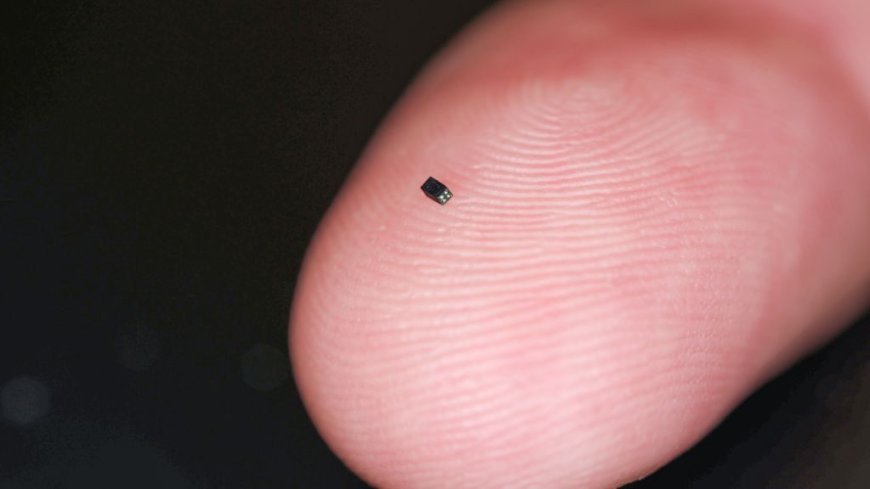Smart Dust: Tiny Sensors That Could Revolutionize the Future
Smart Dust is a network of microscopic sensors that could revolutionize industries by enabling real-time monitoring and data collection. Discover its potential and challenges.

Introduction
Imagine a world where microscopic sensors float in the air, monitoring pollution, tracking diseases, or even securing buildings—all without human intervention. This is the promise of Smart Dust, a revolutionary technology consisting of tiny, wireless microelectromechanical systems (MEMS) that can detect, sense, and transmit data.
Smart Dust is not just a futuristic concept; it's already being developed for applications in healthcare, defense, agriculture, and industrial automation. These microscopic sensors, sometimes as small as a grain of sand, have the potential to transform industries by providing real-time, highly detailed environmental data with unprecedented precision.
How does Smart Dust work? What are its applications and challenges? And how could it redefine the way we interact with the world? Let’s explore.
What Is Smart Dust?
Smart Dust refers to a network of tiny, wireless sensors that can collect and transmit data about their environment. Each particle of Smart Dust, known as a mote, contains:
- Microprocessors to analyze data
- Sensors to measure temperature, humidity, light, motion, or chemicals
- Wireless transmitters to send information to a central system
- Power sources like micro-batteries, energy harvesting, or passive RFID technology
These microscopic sensors can be scattered in the air, embedded in materials, or even placed inside the human body, creating a new level of connectivity and intelligence in the physical world.
How Does Smart Dust Work?
Smart Dust operates through a mesh network, where multiple motes communicate with each other and a central receiver. This allows them to:
- Sense the Environment – Each mote is programmed to detect specific environmental factors like heat, vibration, or chemical compositions.
- Process & Store Data – Built-in microprocessors analyze the collected data before transmission.
- Communicate Wirelessly – Using low-power signals, motes relay information to a nearby hub or network.
- Self-Power & Sustain – Some motes use tiny solar cells, kinetic energy, or ambient radio waves to function without traditional batteries.
Because Smart Dust can function autonomously and does not require physical maintenance, it can be deployed in areas that are difficult or dangerous for humans to access.
Game-Changing Applications of Smart Dust
Smart Dust has the potential to revolutionize industries and daily life. Here are some of the most promising applications:
1. Healthcare & Biotechnology
- Smart Dust can be injected into the human body to monitor vital signs, detect diseases early, and even track cancer cells.
- It could improve prosthetics by providing real-time feedback to the nervous system.
- Hospitals can use Smart Dust for infection control, ensuring sterile environments by detecting harmful bacteria.
2. Military & Defense
- Smart Dust can act as an invisible surveillance system, detecting enemy movements in real-time.
- It can monitor chemical or biological threats in war zones or terrorist-prone areas.
- Defense agencies are researching Smart Dust for cybersecurity, using it to detect unauthorized access to sensitive locations.
3. Industrial & Manufacturing
- Factories can deploy Smart Dust to monitor machine performance, reducing breakdowns and improving efficiency.
- It can be used in supply chain logistics to track goods and materials at a microscopic level.
- Smart Dust can detect leaks in pipelines before they become critical failures.
4. Agriculture & Environmental Monitoring
- Smart Dust can monitor soil moisture, air quality, and crop health, optimizing farming techniques and reducing waste.
- It can track wildlife migration and environmental changes without disrupting ecosystems.
- Governments could use Smart Dust to monitor deforestation, pollution, and climate change more accurately.
5. Smart Cities & Infrastructure
- Smart Dust could automate traffic monitoring, reducing congestion and improving safety.
- It can help detect structural weaknesses in bridges, tunnels, and buildings before disasters occur.
- Cities can use it for real-time energy efficiency management, making urban environments more sustainable.
Challenges & Concerns with Smart Dust
While Smart Dust has enormous potential, there are significant challenges that must be addressed before widespread adoption.
1. Privacy & Security Risks
Since Smart Dust operates invisible to the human eye, it raises ethical concerns about surveillance and data privacy. Governments and organizations must establish strict regulations to prevent misuse.
2. Power & Longevity
Many Smart Dust motes rely on tiny batteries or alternative energy sources, but ensuring long-term power without replacement is a major challenge. Research into self-sustaining energy solutions is crucial for large-scale deployment.
3. Data Overload
With millions of sensors transmitting information, managing and processing vast amounts of data efficiently is a technical hurdle. AI-driven analytics and edge computing will be essential to filter and interpret useful data.
4. Cost & Scalability
While Smart Dust technology is advancing, mass production remains expensive. As manufacturing techniques improve, costs will likely decrease, allowing for wider commercial adoption.
5. Environmental & Ethical Impacts
If not properly managed, Smart Dust could contribute to electronic waste or have unintended consequences on ecosystems. Sustainable materials and biodegradable motes are being explored to minimize the impact.
The Future of Smart Dust
Experts predict that Smart Dust will become mainstream within the next two decades, transforming industries, infrastructure, and even personal health monitoring.
Some potential advancements include:
✔ Biodegradable Smart Dust that dissolves after completing its function, reducing environmental risks.
✔ Self-replicating motes that can repair and upgrade themselves without human intervention.
✔ Advanced AI integration to make Smart Dust systems more autonomous and intelligent.
✔ Direct brain-computer interfaces, where Smart Dust can help restore lost sensory functions in medical patients.
As researchers refine the technology, Smart Dust could soon become as common as WiFi, silently working behind the scenes to optimize our world.
Final Thoughts
Smart Dust is not just science fiction—it is a groundbreaking innovation that could revolutionize industries, enhance security, and improve lives. By embedding intelligence into microscopic sensors, we are unlocking new ways to interact with and monitor our surroundings in real time.
However, as with any disruptive technology, ethical and security concerns must be addressed to ensure responsible development and implementation. The potential is enormous, and in the coming years, Smart Dust may reshape how we gather, process, and use information in ways we never imagined.
What's Your Reaction?
 Like
0
Like
0
 Dislike
0
Dislike
0
 Love
0
Love
0
 Funny
0
Funny
0
 Angry
0
Angry
0
 Sad
0
Sad
0
 Wow
0
Wow
0



















































